![Paul Thomas Minnihan, I Dare to Dream, 3353 W 13th St [Black Neighborhood], Chicago, 1995.jpg Paul Thomas Minnihan, I Dare to Dream, 3353 W 13th St [Black Neighborhood], Chicago, 1995.jpg](https://486312.frmmmguz.asia/files/square_thumbnails/b2254bc5fe1b092ee4f9c95af8c1ebf3.jpg)
I Dare to Dream
I Dare To Dream is a Chicago mural painted in 1995 by artist Paul Thomas Minnihan. Drawing heavily upon local history, the mural includes locals such as the Chicago Bulls player Michael Jordan, astronaut and first African American woman to travel into space, Mae C. Jemison, and Harold Washington, the first African American mayor of Chicago. Alongside the Chicago figures are the faces of Mary McLeod Bethune, Frederick Douglass and Martin Luther King Jr. The west side mural was situated opposite the Douglass Branch of the Chicago Public Library, but no longer exists.
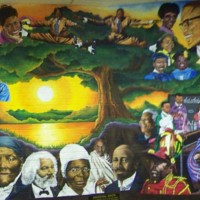
Ancestral Roots
Pontella Mason is one of Baltimore’s unsung visual artists. He has created murals for the Anacostia Community Museum, former President Jimmy Carter, and several other public organisations. His murals depict African American life and the diaspora. In 1999, he created the extensive mural Ancestral Roots, which depicts the antislavery heroes Harriet Tubman, Sojourner Truth, and Frederick Douglass, as well as Martin Luther King Jr., Malcolm X, Muhammad Ali, Notorious B.I.G., Tupac, Shirley Chisholm, and Marcus Garvey.
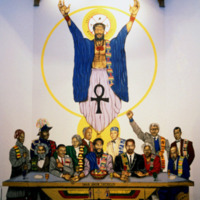
Last Supper
In 1990, muralist Maurice Myron Jenkins created an alternative version of Leonardo da Vinci’s 1494 fresco The Last Supper. The 30 by 19 foot mural depicts the last supper with a black Christ and 12 historical black figures as the prophets. Jenkins chose the Union Temple Baptist Church in Anacostia, Washington D.C. as his canvas because of its role in black history all the way back to its affiliation with Anacostia-resident Frederick Douglass in the 19th century.The mural includes the antislavery figures of Sojourner Truth and Frederick Douglass, as well as Marcus Garvey, Martin Luther King Jr., Rosa Parks, Elijah Muhammad, Malcolm X, Mary McLeod Bethune, Nelson Mandela, Booker T. Washington and W.E.B. Du Bois.
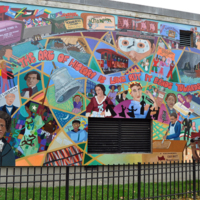
The Arc of History is Long
The muralist David Fichter adapted Martin Luther King Jr.’s famous quotation “the arc of the moral universe is long but it bends towards freedom,” for this 2002 mural in Cambridge, Massachusetts. The mural features Susan B. Anthony, Rosie the Riveter, William Lloyd Garrison and W.E.B. Du Bois, as well as a young Frederick Douglass.At around the same age as he appears in this mural, Douglass gave a speech in nearby Boston on February 8, 1855 where he drew attention to the psychological impact of enslavement: “Whipping is not what constitutes the cruelty of Slavery," explained Douglass. “To me the thought that I am a slave is more terrible than any lash, than any chain.”
![Curtis Lewis, African Amalgamation of Ubiquity, 9980 Gratiot Avenue, Detroit, Michigan, 1985 [destroyed in 2013].jpg Curtis Lewis, African Amalgamation of Ubiquity, 9980 Gratiot Avenue, Detroit, Michigan, 1985 [destroyed in 2013].jpg](https://486312.frmmmguz.asia/files/square_thumbnails/3ac63b31ad894031e7c74b99651ace4a.jpg)
African Amalgamation of Ubiquity
In 1985, muralist Curtis Lewis created a mural on the side of a drug rehabilitation centre on Gratiot Avenue, Detroit, Michigan. The building belonged to Operation Get Down and included the antislavery figures Frederick Douglass and Harriet Tubman, as well as Malcolm X, Mary McLeod Bethune, Jesse Jackson, Thurgood Marshall, Martin Luther King Jr., W.E.B. Du Bois, Booker T. Washington, Ida B. Wells, Marcus Garvey and Nelson Mandela, alongisde Egyptian, Nubian and pharaoh figures. The man who breaks free of his chains in the centre of the mural holds a sign that reads, “Behold my people, arise, stand strong and proud, for ye come from pharaohs, emperors, kings and queens.” The mural was destroyed in 2013.
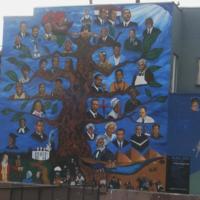
Black Seeds
In 1991, a group of artists – Eddie Orr, David Mosley, William T. Stubbs, Norman Maxwell and Michael McKenzie – collaborated to paint “Black Seeds” on an empty wall in Leslie N. Shaw Park on Jefferson and 3rd Avenue in Los Angeles. The idea for the mural, which appears as an African American tree of life, came from Vietnam veteran and local activist Gus Harris Jr. He recalled how little he learned about African American history in school. He wanted to create a public mural about black individuals who made an important contribution to society.The mural was created under the Social and Public Art Resource Center's 1990-91 “Neigborhood Pride: Great Walls Unlimited” mural program and features the antislavery leaders Harriet Tubman and Frederick Douglass, as well as Booker T. Washington, Thurgood Marshall, Mary McLeod Bethune, Malcolm X, George Washington Carver, Paul Robeson, Stevie Wonder, Shirley Chisholm, Martin Luther King Jr., and Jesse Jackson. The mural was restored by Moses X. Ball to include Barack Obama after 2008. The original canvas upon which the mural was based hangs in Oaks Jr. Market Corner Store at 5th and Jefferson.
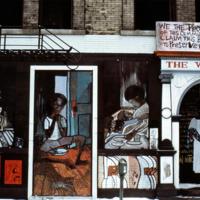
Wall of Truth
Although sharing an address with the famous Wall of Respect, the Wall of Truth was different. Whilst the Wall of Respect exalted black role models, leaders and liberators, the Wall of Truth wove negative scenes of poverty, brutality and racism into the fabric of the urban environment. Rather than promoting racial pride, it highlighted racial disparities. “The intent on the opposite side [of the road] was that things had gone more militant,” muralist Eugene Wade explained: “more blackness was needed in terms of representing the Black Power symbol and the whole thrust of what was happening in the black community.” Wade notes that “people were getting angry and fed up, so what we were trying to do was implement the attitude and the mood."The Wall of Truth was a significantly larger mural than its Chicago neighbour, the Wall of Respect. It spanned the length of an apartment building, and wrapped around onto an adjoining wall. It contained nine separate narrative panels and was one of the first instances that a radical black past was visualised in the streets through the antislavery leaders Frederick Douglass and Nathaniel Turner, as well as Mary McLeod Bethune, W.E.B. Du Bois, H. Rap Brown, Stokely Carmichael, Marcus Garvey, Huey P. Newton, Fred Hampton, and Malcolm X.
![Parkview Recreation Center Mural, Northwest at Otis Pl (Black Neighborhood), Washington DC, 1990s [destroyed 2010].jpg Parkview Recreation Center Mural, Northwest at Otis Pl (Black Neighborhood), Washington DC, 1990s [destroyed 2010].jpg](https://486312.frmmmguz.asia/files/square_thumbnails/2f5b42d937293f1b46430d226884e60b.jpg)
Parkview Recreation Center Mural
This mural was painted in the 1990s on the side of the Parkview Recreation Center in northwest Washington D.C. It depicts the faces of Thurgood Marshall, Mary McCleoud Bethune and the antislavery leader Frederick Douglass. In 2010 the mural was repainted and includes the same faces.
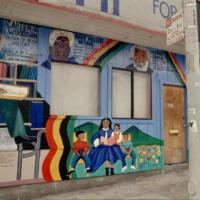
Scenes from the Bayview Opera House
Painted in 1995 in San Francisco by artist Leboriae P. Smoore, this mural acts as a children’s textbook in the street, teaching about the antislavery leaders Harriet Tubman and Frederick Douglass, and other black figures: Carter G. Woodson, Mary McLeod Bethune, W.E.B. Du Bois, Ida B. Wells, and Jackie Robinson.
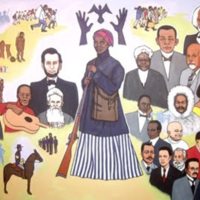
From Africa to America
Wilfred R. Stroud created this seven-panel mural in 1988 to be installed on the first floor of the Tubman Museum. It remains a signature piece in the Museum’s collection today. When the mural was being created, Stroud expained: “The purpose of this mural is to present a visual history of the black man and woman from the earliest times in Africa to the present times in America. The panels focus attention upon the impact of outstanding persons, and events that made a change in the lives and conditions of black people in particular, and the world in general.” Stroud dedicated an entire panel to the topic of slavery. Harriet Tubman stands in the centre, holding a rifle and surrounded by other antislavery leaders: Sojourner Truth, Abraham Lincoln, Frederick Douglass and John Brown.
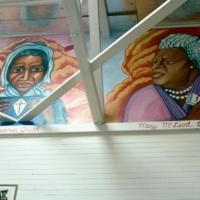
The Great Cloud of Witnesses
In 1992, Selma Brown, Susan Cervantes and Ronnie Goodman painted images of the antislavery leaderes Sojourner Truth, Harriet Tubman and Frederick Douglass, as well as Mary McLeod Bethune, W.E.B. Du Bois, and Thurgood Marshall, at Ingleside Presbyterian Church and Community Center in San Francisco, California. The mural, titled The Great Cloud of Witnesses, was started by Revered G. when he pasted a single newspaper clipping of his hero, Muhammad Ali to the wall of the church gymnasium in 1980. Over the decades, the collage expanded to cover the entire gym, fellowship hall, stairways, hallways, bathrooms, basement and meeting rooms. The mural is multi-faceted and contains newspapers, magazine clippings, photographs, flyers, posters, prints, poetry and painted murals.
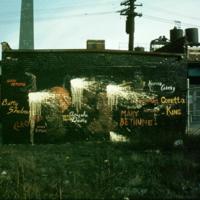
Racism
In 1970, a mural titled Racism appeared in the Cabrini-Green Housing Projects in Chicago’s southside. It celebrated black women who had been key participants in the struggle for black liberation. The mural depicted the faces of Nina Simone, Angela Davis and Kathleen Cleaver, along with the names of Aunt Jemima, Betty Shabazz, Cleopatra, Mary McLeod Bethune, Coretta Scott King and the abolitionist Sojourner Truth. The mural was defaced with white paint shortly after its completion.
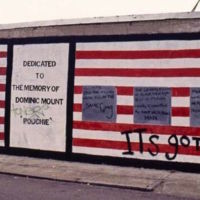
All in the Same Gang
In 1998, at the height of gang related murders in the city of Boston, Jameel Parker was commissioned to paint a mural by Gang Peace, a not-for-profit, street-based programme seeking to reduce the number of murders in Boston by redirecting youths into education and career-oriented activities. In 1992, around 600 local youths between the ages of 8 and 23 participated in Gang Peace programmes. Parker’s mural, titled All in the Same Gang, was painted in Boston and became a monument to those who had died as a result of gang crime. During its creation, on the corner of the street where the mural was painted – Blue Hill Avenue and Floyd Street – a young boy named Dominic Mount was murdered. Given the immediate community outcry following his death, Parker dedicated the mural to Mount and placed his name alongside heroes of Black history; Frederick Douglass, W.E.B. Du Bois, Malcolm X and Elijah Muhammad. By 2016, the portraits of the African American male leaders had faded and the mural had changed to now include four black women, includng abolitionist Harriet Tubman.